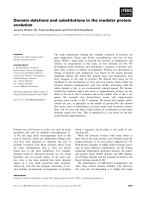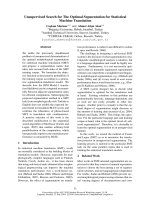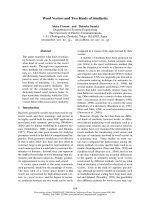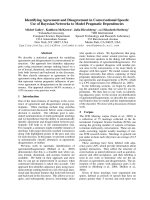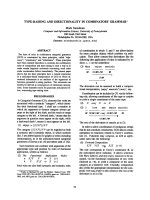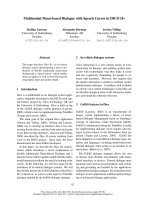Báo cáo khoa học: "ON FORMALISMS AND ANALYSIS, GENERATION AND SYNTHESIS IN MACHINE TRANSLATION" pptx
Bạn đang xem bản rút gọn của tài liệu. Xem và tải ngay bản đầy đủ của tài liệu tại đây (585.52 KB, 8 trang )
ON FORMALISMS AND ANALYSIS, GENERATION AND
SYNTHESIS IN MACHINE TRANSLATION
Zaharin Yusoff
Projek Terjemahan Melalui Komputer
PPS. Matematik & Sains Komputer
Universiti Sains Malaysia
11800 Penang
Malaysia
Introduction
A formalism is a set of notation with
well-defined semantics (namely for the
interpretation of the symbols used and
their manipulation), by means of which
one formally expresses certain domain
knowledge, which is to be utilised for
specific purposes. In this paper, we are
interested in formalisms which are being
used or have applications in the domain
of machine translation (MT). These can
range from specialised languages for
linguistic programming (SLLPs) in NIT,
like ROBRA in the ARIANE system
and GRADE in the Mu-system, to
linguistic formalisms like those of the
Government and Binding theory and the
Lexical Functional Grammar theory. Our
interest lies mainly in their role in the
domain in terms of the ease in
expressing linguistic knowledge required
for MT, as well as the ease of
implementation in NIT systems.
We begin by discussing formalisms
within the general context of MT, clearly
separating the role of linguistic
formalisms on one end, which are more
apt for expressing linguistic knowledge,
and on the other, the SLLPS which are
specifically designed for MT systems.
We argue for another type of formalism,
the general formalism, to bridge the gap
between the two. Next we discuss the
role of formalisms in analysis and in
generation, and then more specific to
NIT, in synthesis. We sum up with a
mention on a relevant part of our current
work, the building of a compiler that
generates a synthesis program in SLLP
from a set of specifications written in a
general formalism.
On formalisms in MT
The field of computational linguistics
has seen many formalisms been
introduced, studied and compared with
other formalisms. Some get established
and have been or are still being widely
used, some get modified to suit newer
needs or to be used for other purposes,
while some simply die away. Those that
we are interested in are formalisms
which play some role in MT.
The MT literature has cited formalisms
like the formalisms for the government
and Binding Theory (GB) [Chomsky
81], the Lexical Functional Grammar
(LFG) [Bresnan & Kaplan 82], the
Generalized Phrase structure Grammar
(GPSG) [Gazdar & Pullum 82] (here
we refer to the formalisms provided by
these linguistic theories and not the
linguistic content), Context Free
Grammar (CFG), Transformational
Grammar (TG), Augmented Transition
Networks (ATN) [Woods 70], ROBRA
[Boitet 79], grade [Nagao et al. 80],
metal [Slocum 84], Q-systems
[Colmerauer 71], Functional Unification
Grammar (FUG) [Kay 82], Static
Grammar (SG) [Vauquois & Chappuy
85], String-Tree Correspondence
Grammar (STCG) [Zaharin 87a],
Definite Clause Grammar (DCG)
[Warren & Pereira 80], Tree Adjoining
Grammar (TAG) [Joshi et al. 75], etc.
To put in perspective the discussions to
follow, we present in Figure 1 a rather
naive but adequate view of the role of
certain formalisms in biT.
- 319 -
General SLLPs
Formalisms
Fig. 1 - The role of formalisms in MT.
GB, LFG and GPSG formalisms are
classed as linguistic formalisms as they
have been designed purely for linguistic
work, clearly reflecting the hypotheses
of the linguistic theories they are
associated to. Although there have been
'LFG-based' and 'GPSG- inspired' MT
systems, a LFG or GPSG system for
MT has yet to exist. Whether or not
linguistic formalisms are suitable for MT
(one argues that linguistic formalisms
tend to lean towards generative
processes as opposed to analysis, the
latter being considered very important to
MT) is not a major concern to linguists.
Indeed it should not be, as one tends to
get the general feeling that formal
linguistics and MT are separate
problems, although tapping from the
same source. If this is indeed true, there
is no reason why one should try to
change linguistic formalisms into a form
more suitable for MT.
Linguistics has been, is still, and will
continually be used in MT. What is
currently been done is that linguistic
knowledge, preferably expressed in
formal terms using a linguistic
formalism, is coded into a MT system by
means of the SLLPs. SLLPs include
formalisms like ATN, ROBRA, GRADE,
METAL and Q- systems. Tree
structures are the main type of data
structure manipulated in MT systems,
and the SLLPs are mainly tree
transducers, string-tree transducers
and/or tree-string transducers. Such
mechanisms are arguably very suitable
for defining the analysis process
(parsing a text to some representation
of its meaning) and the synthesis
process (generating a text form a given
representation of meaning). SLLPs
which work on feature structures have
also been introduced, but these also
work on the same principle.
Despite the fact that SLLPs are
specifically designed for programming
linguistic data, and that most of them
separate the static linguistic data
(linguistic rules) from the algorithmic
data (the control structure), the problem
is that they are still basically
programming languages. Indeed, during
the period of their inception, they may
have been thought of as the MT's
answer to a linguistic formalism, but it is
no longer true these days. To begin with,
most if not all SLLPs are procedural in
nature, which means that a description
can be read in only one direction
(not
bidirectional),
either for analysis or for
synthesis. Consequently, for every
natural language treated in a MT
system, two sets of data will have to be
written: one for analysis and one for
synthesis. Furthermore, also due to this
procedural nature, ling.uistic rules in
SLLPs are usually written with some
algorithm in mind. Hence, although
separated from the algorithmic
component, these linguistic rules are not
totally as declarative as one would have
hoped
(not declarative).
For these
reasons, as well as for the fact that
SLLPs are very system oriented, data
written in SLLPs are rarely retrievable
for use in other systems
(not portable).
It was due to these shortcomings that
other formalisms for MT which are
bidirectional, declarative and not totally
system oriented have been designed.
Such formalisms include the SG and its
more formal version, the STCG. One
first notes that these formalisms are not
designed to replace linguistic
formalisms. There may be some
linguistic justifications (e.g. in terms of
the linguistic model [Zaharin 87b], but
- 320 -
they are designed principally for bridging
the gap between linguistic formalisms
and SLLPs. Such formalisms are
designed to cater for MT problems, and
hence may not directly reflect linguistic
hypotheses but simply have the
possibility to express them in a manner
more easibly interl?.retable for MT. They
are declarative m nature and also
bidirectional. Only one set of data is
required to describe both analysis and
generation. They are also general in
nature, meaning that it is possible to
express different linguistic theories
using these formalisms, and also that it
is possible to implement these
formalisms using various SLLPs. One
can view such formalisms as
specifications for writing SLLPs,
as
illustrated in Figure 2 (akin to
specifications used in software
engineering).
I linguistic knowledge
(in linguistic formalisms)
I specifications
(in general formalisms)
%
implementation
(in
SLLPs)
Fig. 2 General formalisms as
specifications
Other formalisms that can be
considered to be within this class of
general formalisms are TAG, FUG, and
perhaps DCG. With such formalisms,
one may express knowledge from
various linguistic theories (possibly a
mixture), and that the same set of
represented knowledge may be
implemented for both analysis and
synthesis using various SLLPs in
different MT systems (as illustrated in
Figure 3).
D I LF° I l°PS°l
l
ROBRA
in
ARIANE
general
formalisms
GRADE
inMu-
system
ATLAS
Fig. 3 - the central role of general
formalisms
On specifications for analysis
and synthesis
The two main processes in MT are
analysis and synthesis (a third process
called transfer is present if the approach
is not interlingual). Analysis is the
process of obtaining some
representation(s) of meaning (adequate
for translation) from a given text, while
synthesis is the reverse process of
obtaining a text from a given
representation of meaning
1.
Analysis
and synthesis can be considered to be
two different ways of interpreting a
single concept, this concept being a
correspondence between the set of all
possible texts and the set of all possible
representations of meaning in a
language. This correspondence is
basically made up of a set of texts (T), a
set of representations (S), and a relation
between the two R(T,S), defined in
terms of relations between elements of
T and elements of S. We illustrate this
in Figure 4.
- 321 -
f Set of "
Representations
T
- relation between
texts and
.~ representations
R(T,S) =
{R(T,S) : t ~ T, s ~ S}
Fig. 4 - The correspondence between
texts and their representations
Supposing that a correspondence as
given in Figure 4 has been defined,
analysis is then the process of
interpreting the relation R(T,S) in such a
way that given a text t, its
corresponding representation s is
obtained. Conversely, synthesis is the
process of interpreting R(T,S) in such a
way that given s, t is obtained. Clearly,
a general formalism to be used as
specifications must be capable of
defining the correspondence in Figure 4.
Defining the correspondence may entail
defining just one, two, or all three
components of Figure 4 depending on
the complexity of the results required.
When one works on a natural language,
one cannot hope to define the set of
texts T (unless it is a very restricted
sublanguage). Instead, one would
attempt to define it by means of the
definition of the other two components.
As an example, the CFG formalism
defines only the component R(T,S) by
means of context-free rules. This
component generates the set of texts (t)
as well as all possible representations
(S) given by the parse trees. The
formalism of GB defines the relation
R(T,S) by means of context-free rules
(constrained by the Xbar-theory), move-
o~ rules (constrained by bounding
theory), the phonetic interpretative
component and the logical interpretative
component. This relation generates the
set of all texts (T) and all candidate
representations (S) (logical structures).
The set S is however further defined
(constrained) by the binding theory, 0-
theory and the empty category principle.
As a third example, the STCG formalism
defines R(T,S) by means of its rules,
which in turn generates S and T. The set
S is however further defined by means of
constraints on the writing of the STCG
rules.
Having set the specifications for
analysis and synthesis by means of a
general formalism, one can then proceed
to implement the analysis and
synthesis. Ideally, one should have an
interpreter for the formalism that works
both ways. However, an interpreter
alone is not enough to complete a MT
system : one has to consider other
components like a morphological
analyser, a morphological generator,
monolingual dictionaries, and for non-
interlingual systems, a transfer phase
and bilingual dictionaries. In fact, such
an interpreter alone will not complete
the analysis nor the synthesis, a point
which shall be discussed as of the next
paragraph. For these reasons, the
specifications given by the general
formalism are usually implemented using
available integrated systems, and hence
in their SLLPs.
For analysis, apart from the linguistic
rules given by the general formalism,
there is the algorithmic component to be
added. This is the control structure that
decides on the sequence of application of
rules. A general formalism does not, and
should not, include the algorithmic
component in its description. The
description should be static. There is
also the problem of lexical and structural
ambiguities, which a general formalism
does not, and should not, take into
consideration either. A fully descriptive
and modular specification for analysis
should have separate components for
linguistic rules (given by the formalism),
algorithmic structure, and
disambiguation rules. Apart from being
theoretically attractive, such modularity
leads to easier maintenance (this
discussion is taken further in [Zaharin
88]); but most important is the fact the
same linguistic rules given by the
- 322 -
formalism will serve as specifications for
synthesis, whereas the algorithmic
component and disambiguation rules will
not.
In general, synthesis in MT lacks a
proper definition, in particular for transfer
systems 2. It is for this reason (and other
reasons similar to those for analysis)
That the specifications for synthesis
given by the general formalism play a
major role but do not suffice for the
whole synthesis process. To clarify this
point, let us look at the classical global
picture for MT in second generation
s.ystems given in Figure 5. The figure
gives the possible levels for transfer
from the word level up to interlingua, the
higher one goes the deeper the
meaning.
Inter]ingua
Relations
Logical Relatk
mum
Syntactic Function
Syntagmatic Class
Ib
Lexical Units
Lemmas
Words
Source Target
Text Text
Fig. 5 - The levels of transfer in second
generation
MT systems
Most current systems attempt to go
as
high as the level of semantic relations
(eg. AGENT, PATIENT,
INSTRUMENT) before embarking on
the transfer. Most systems also retain
some lower level information (eg. logical
relations, syntactic functions and
syntagmatic classes) as the analysis
goes deeper, and the information gets
mapped to their equivalents in the target
language. The reason for this is that
certain lower level information may be
needed to help choose the target text to
be generated amongst the many
possibilities that can be generated from
a given target representation; the other
reason is for cases that fail to attain a
complete analysis (hence fail-soft
measures).
The consequence to the above is that
the output of the transfer, and hence the
input to synthesis, may contain a
mixture of the information. Some of this
information are pertinent, namely the
information associated to the level of
transfer (in this case the semantic
relations, and to a large extent the
logical relations), while the rest are
indicative. The latter can be considered
as heuristics that helps the choice of the
target text as described above.
Whatever the level of transfer chosen,
there is certainly a difference between
the input to synthesis and the
representative structure described in the
set S in Figure 4, the latter being
precisely the representative structure
specified in the general formalism. In
consequence, if the synthesis is to be
implemented true to the specifications
given by the general formalism (which
have also served as the specifications
for analysis), the synthesis phase has to
be split into two subphases: the first
phase has the role of transforming the
input into a structure conforming to the
one specified by the formalism (let us
call this subphase SYN1), and the other
does exactly as required by the general
formalism, ie. generate the required text
from the given structure (call this phrase
SYN2). The translation process is then
as
illustrated in Figure 6.
As mentioned, the phase SYN2 is
exactly as specified by the general
formalism used as specifications. What
is missing is the algorithmic component,
which is the control structure which
decides on the applications of rules.
However, the phase SYN1 needs some
careful study. Some indication is given in
the discussion on some of our current
work.
- 323 -
Analys
Source [
Text
Transfer
~'- ( Input
/
/
Specifications
in General ~)
Formalism
Fig.6 - The splitting of synthesis
SYN1
Specified
Structure
SYN2
[ T~eg~t J
Some relevant current work at
PTMK-GETA
Relevant to the discussion in this
paper, the following is some current
work undertaken within the cooperation
in MT between PTMK (Projek
Terjemahan Melalui Komputer) in
Penang and GETA (Groupe d'Etudes
pour la Traduction Automatique) in
Grenoble.
The formalisms of SG, and its more
formal version STCG, have been used as
specifications for analysis and synthesis
since 1983, namely for MT applications
for French-English, English-French and
English-Malay, using the ARIANE
system. However, not only the
implementations have been in the SLLP
ROBRA in ARIANE, the transfer from
specifications (given by the general
formalism) to the implementation
formalism has also been done manually.
One .project undertaken is the
construction of an interpreter for the
STCG which will do both analysis and
generation. Some appropriate
modifications will enable the interpreter
to handle synthesis (SYN2 above). At
the moment, implementation
specifications are about to be completed,
and the implementation is proposed to
be carried out in the programming
language C.
Another project is the construction of a
compiler that generates a synthesis
program in ROBRA from a given set of
specifications written in SG or STCG.
Implementation specifications for SYN2
is about to be completed, and the
implementation is proposed to be carded
out in Turbo-Pascal. The algorithmic
component in SYN2 will be
automatically deduced from the
REFERENCE mechanism of the
SG/STCG formalism. The automatic
generation of a SYN1 program poses a
bigger problem. For this, the output
specifications are given by the SG/STCG
rules, but as mentioned earlier, the input
specifications can be rather vague. To
overcome this problem, we are forced to
look more closely into the definitions of
the various levels of interpretation as
indicated in Figure 5, from which we
should be able to separate out the
pertinent from the indicative type of
information in the input structure to
SYN1 (as discussed earlier). Once this
is done, the interpretation of SG/STCG
rules for generating a SYN1 program in
ROBRA will not pose such a big
problem (the problem is theoretical, not
of implementation in fact,
specifications for implementation for this
latter part have been laid down, pending
on the results of the theoretical
research).
Concluding remarks
The MT literature cites numerous
formalisms. The formalisms, can be
generally classed as linguistic
-
324 -
formalisms, SLLPs and general
formalisms. The linguistic formalisms
are designed purely for linguistic work,
while SLLPs, although designed for MT
work, may lack certain desirable
properties like bidirectionality,
declarativeness and portability. General
formalisms have been designed to bridge
the gap between the two extremes, but
more important, they can serve as
specifications in MT. However, such
formalisms may still be insufficient to
specify the entire MT process. There is
perhaps a call for more theoretical
foundations with more formal definitions
for the various processes in MT.
Footnotes
1. The term generation has sometimes
been used in place of synthesis, but this
is quite incorrect. Generation refers to
the process of generating all possible
texts from a given representation,
usually an axiom, and this is irrelevant
in MT apart from the fact that synthesis
can be viewed as a subprocess of
generation.
2. Interlingual systems may not lack
the definition for synthesis, but they lack
the definition for interlingua itself. To
date, all interlingual systems can be
argued to be transfer systems in a
different guise.
References
Ch. Boitet - Automatic production of
CF and CS-analyzers using a general
tree transducer.
2. Internationale
K. olloquium iiber Maschinelle
Ubersetzung, Lexicographie und
Analyse,
Saarbrticken, 16-17 Nov. 1979.
J. Bresnan and R.M. Kaplan - Lexical
Functional Grammar: a formal system
for
grammatical representations. In
The
Mental Representation of Grammatical
Relations,
J. Bresnan (ed), Mrr Press,
Cambridge, Mass., 1982.
N.
Chomsky -
Lectures on Government
and Binding
(the Pisa Lectures), Foris,
Dordrecht, 1981.
A. Colmerauer - Les syst~mes-Q ou
un formalisme pour analyser et
synthttiser des phrases sur ordinateur.
TAUM, Universit6 de Montrtal, 1971.
G. Gazdar and G.K. Pullum -
Generalized Phrase Structure Grammar:
a theoretical synopsis.
Indiana
University Linguistics Club,
Bloomington, Indiana, 1982.
A. Joshi, L. Levy and M. Takahashi -
Tree Adjunct Grammars.
Journal of the
Computer and System Sciences
10:1,
1975.
M. Kay - Unification Grammar. Xerox
Palo Alto Research Center, 1982.
M. Nagao, J. Tsujii, K. Mitamura, H.
Hirakawa and M. Kume A machine
translation system from Japanese into
English another perspective of MT
systems.
Proceedings of COLING 80,
Tokyo, 1980.
J. Slocum - METAL: The LRC machine
translation system. ISSCO Tutorial on
Machine Translation, Lugano,
Switzerland, 1984.
B. Vauquois and S. Cilappuy - Static
Grammars: a formalism for the
description of linguistic models.
Proceedings of the Conference on
Theoretical and Methodological Issues
in Machine Translation of Natural
Languages,
Colgate University,
Hamilton, NY, 1985.
D.H.D. Warren and F.C.N. Pereira -
Definite Clause Grammars for language
analysis. A survey of the formalism and
a comparison with ATNs;
Artificial
Intelligence
13, 1980.
W.A. Woods Transition Network
Grammars for natural language analysis.
Communications of the ACM
13:10, 1970.
Y. Zaharin - String-Tree
Correspondence Grammar: a declarative
grammar formalism for defining the
correspondence between strings of
terms and tree structures.
3rd
Conference of the European Chapter of
the Association for Computational
Linguistics,
Copenhagen, 1987.
- 325 -
Y. Zaharin - The linguistic approach at
GETA: a synopsis.
Technologos 4
(printemps 1987), LISH-CNRS, Paris.
Y. Zaharin - Towards an analyser
(parser) in a machine translation system
based on ideas from expert systems.
Computational Intelligence
4:2, 1988.
- 326-
